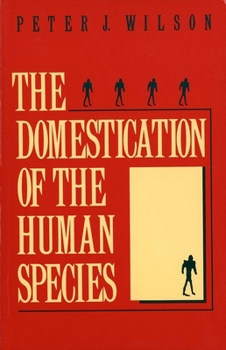The Domestication of the Human Species
Select Format
Select Condition 
Book Overview
In this exciting new book the author of Man, the Promising Primate takes domestication as the starting point for his continued inquiry into human evolution. Peter J. Wilson believes that the most radical and far-reaching innovation in human development was this settling down into a built environment, and he argues that it had a crucial effect on human psychology and social relations. His insights not only offer an enriched understanding of human behavior and human history but also point the way toward amendments to long-standing social theories.
Format:Paperback
Language:English
ISBN:0300050321
ISBN13:9780300050325
Release Date:January 1991
Publisher:Yale University Press
Length:201 Pages
Weight:0.80 lbs.
Dimensions:0.7" x 6.0" x 9.2"
Customer Reviews
2 ratings
Interesting perspective on spatial organization
Published by Thriftbooks.com User , 23 years ago
The author presents a fascinating and original view on the spatial organization of culture, with many wide-ranging implications. The "domestication" of humans occurred when fomerly nomadic peoples settled down to a sedentary, agricultural (Neolithic) life. Whereas nomaic hunter/gatherers have a "focus-oriented" spatial framework, domesticated people have a "boundary-oriented" framework. Architecture and walls have a fundamental influence over behavior, ideas, and culture.Although the book has many fascinating insights, it suffers from the overly-broad category of "domesticated cultures." These include everything from the Neolithic revolution up to the industiral revolution. For Wilson, there is very little difference between tribal Neolithic cultures and the preindustrial states of antiquity. Yet the social organizations, use of space, and many other aspects of culture differ widely within "domesticated cultures," and this variation weakens considerably the applicability of Wilson's insights.The book is nevertheless worth reading for its numerous insights and fresh ideas. For example, he suggests that Roy Rappaport's characterization of rituals (repetition, formal structure, unity, etc.) can be applied to architecture. This has numerous implications (not fully explored by Wilson) and constitutes an independent approach to the built-environment theme of Amos Rapaport and others.
A Masterpiece
Published by Thriftbooks.com User , 24 years ago
This book offers the best understanding so far of the basics of human evolution. The writing of a very sophisticated yet obvious process in such a clear and understandable way makes this book a masterpiece.By incorporating the concepts of Wilson's evolution theories into the study of psychology and humanities we, potentially, have the key for an 'evolutionary jump'of understanding how we got here and why.






